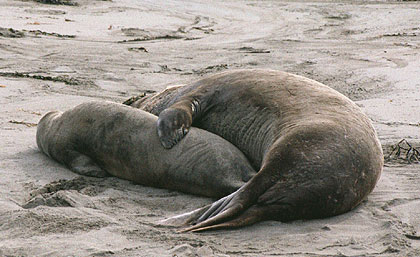February 14 is a day for love, and if you visit the Piedras Blancas bluffs near San Simeon, California on that day, you will see more love-making on the beach than ever before.
 That’s right. I’m talking northern elephant seals. As I write (January), the adult females are birthing pups, and the way the gulls are bounding about the beach cleaning up the birthing mess, it looks like popcorn gone mad with wings. The 2010 female and pup count far exceeds the last two years, according to stats taken by Brian Hatfield, the marine biologist on site.
That’s right. I’m talking northern elephant seals. As I write (January), the adult females are birthing pups, and the way the gulls are bounding about the beach cleaning up the birthing mess, it looks like popcorn gone mad with wings. The 2010 female and pup count far exceeds the last two years, according to stats taken by Brian Hatfield, the marine biologist on site.
Thousands of visitors from around the world flock like the gulls for the unique opportunity to watch these migratory seals give birth on the beach. Birthing takes place once a year during the winter months, after the females make a 2500-mile migration from open sea to the Piedras Blancas rookery.
How does this relate to Valentine’s Day? First, let me explain that female northern elephant seals are pretty much bare-flippered and pregnant most of their lives. So, after the female gives birth, she nurses her pup for about 28 days. (The 70- pound pup will weigh in at over 300-pounds when it’s weaned.) She’ll turn her back on the little guy and (OMIT) now contend with a two-ton love machine, because she is now in estrus.
Most births occur around mid-January, consequently supplying harems of females-in-estrus on February 14. The alpha bulls, many weighing in at two-tons and about 16-feet long, have waited all year for this. And because any given northern elephant seal bull has less than a 10% chance of ever breeding in its lifetime, they take this seriously.
What are you likely to see on February 14? Still some females giving birth and/or nursing their pups; squawking pups and weaners; lucky alpha bulls in the act; squirrely beta bulls trying to sneak in “a little” while the alpha bull is engaged; fights between males that make television wrestlers look like wimps; and absolute chaos. Human visitors will laugh, scream, blush, and click jillions of photos and roll miles of video. WE folks in the blue jackets that identify us as docents, will answer a million questions that range from “Can’t you stop them from fighting?” to “What is that?” Let’s just say the male e-seal needs no male enhancement herbs.
As Spring marches in, the adult e-seals return to their migratory paths. The pups—now weaners—play on the beach, learn how to swim and how to hunt so that by April they can begin their eight months at sea.
Also during March, Friends of the Elephant Seal host their annual fundraiser in a historical Hearst Ranch warehouse in San Simeon, California. This event helps fund the non-profit organization’s elephant seal and marine environment educational mission. Visit www.elephantseal.org for more information.
Click play to learn more.
Charmaine Coimbra is a docent for Friends of the Elephant Seal. She also edits and writes an environmental blog about our seas, www.Neptune911.wordpress.com, as well as, www.CharmainesMusePallet.wordpress.com
photo courtesy of BigSurCalifornia.org
 ✓ If you'd like to subscribe to YourLifeisaTrip.com and be notified when new articles appear, click here. It's free, it's fun, and it keeps you on the cutting edge of what our writers are thinking.
✓ If you'd like to subscribe to YourLifeisaTrip.com and be notified when new articles appear, click here. It's free, it's fun, and it keeps you on the cutting edge of what our writers are thinking.